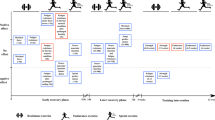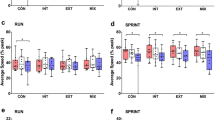Abstract
Purpose
This study examined the effects of combined cooling and lower body heat maintenance during half-time on second-half intermittent sprint performances.
Methods
In a repeated measures design, nine males completed four intermittent cycling trials (32.1 ± 0.3 °C and 55.3 ± 3.7% relative humidity), with either one of the following half-time recovery interventions; mixed-method cooling (ice vest, ice slushy and hand cooling; COOL), lower body passive heating (HEAT), combined HEAT and COOL (COMB) and control (CON). Peak and mean power output (PPO and MPO), rectal (Tre), estimated muscle (Tes-Mus) and skin (TSK) temperatures were monitored throughout exercise.
Results
During half-time, the decrease in Tre was substantially greater in COOL and COMB compared with CON and HEAT, whereas declines in Tes-Mus within HEAT and COMB were substantially attenuated compared with CON and COOL. The decrease in TSK was most pronounced in COOL compared with CON, HEAT and COMB. During second-half, COMB and HEAT resulted in a larger decrease in PPO and MPO during the initial stages of the second-half when compared to CON. In addition, COOL resulted in an attenuated decrease in PPO and MPO compared to COMB in the latter stages of second-half.
Conclusion
The maintenance of Tes-Mus following half-time was detrimental to prolonged intermittent sprint performance in the heat, even when used together with cooling.






Similar content being viewed by others
Abbreviations
- MPO:
-
Mean power output
- COMB:
-
Combined upper body cooling and lower body passive heating
- CON:
-
Control
- COOL:
-
Upper body cooling
- HEAT:
-
Lower body passive heating
- HR:
-
Heart rate
- PPO:
-
Peak power output
- SS:
-
Single sprint
- RPE:
-
Rating of perceived exertion
- RS:
-
Repeated sprint
- T B :
-
Body temperature
- T C :
-
Core temperature
- T es-Mus :
-
Estimated muscle temperature
- T m :
-
Muscle temperature
- T re :
-
Rectal temperature
- TS:
-
Thermal sensation
- T SK :
-
Mean skin temperature
- USG:
-
Urine-specific gravity
- VO2peak :
-
Peak oxygen uptake
References
Aldous JWF, Chrismas BCR, Akubat I, Stringer CA, Abt G, Taylor L (2018) Mixed-methods pre-match cooling improves simulated soccer performance in the heat. Eur J Sport Sci 19:1–10
Allen PB, Salyer SW, Dubick MA, Holcomb JB, Blackbourne LH (2010) Preventing hypothermia: comparison of current devices used by the US Army in an in vitro warmed fluid model. J Trauma Acute Care Surg 69:S154–S161
Beaven CM, Kilduff LP, Cook CJ (2018) Lower-limb passive heat maintenance combined with pre-cooling improves repeated sprint ability. Front Physiol 9:1064
Bishop D, Maxwell NS (2009) Effects of active warm up on thermoregulation and intermittent-sprint performance in hot conditions. J Sci Med Sport 12:196–204
Borg GA (1982) Psychophysical bases of perceived exertion. Med sci sports exerc 14:377–381
Brade C, Dawson B, Wallman K (2014) Effects of different precooling techniques on repeat sprint ability in team sport athletes. Eur J Sport Sci 14:S84–S91
Burton AC (1935) Human calorimetry: II The average temperature of the tissues of the body: three figures. J Nutr 9:261–280
Castle PC, Macdonald AL, Philp A, Webborn A, Watt PW, Maxwell NS (2006) Precooling leg muscle improves intermittent sprint exercise performance in hot, humid conditions. J Appl Physiol 100:1377–1384
Choo HC, Nosaka K, Peiffer JJ, Ihsan M, Abbiss CR (2017) Ergogenic effects of precooling with cold water immersion and ice ingestion: a meta-analysis. Eur J Sport Sci 18:1–12
Drust B, Rasmussen P, Mohr M, Nielsen B, Nybo L (2005) Elevations in core and muscle temperature impairs repeated sprint performance. Acta Physiol 183:181–190
Duffield R, Steinbacher G, Fairchild TJ (2009) The use of mixed-method, part-body pre-cooling procedures for team-sport athletes training in the heat. J Strength Condition Res 23:2524–2532
Edholm P, Krustrup P, Randers M (2015) Half-time re-warm up increases performance capacity in male elite soccer players. Scand J Med Sci Sports 25:e40–e49
Faulkner SH, Ferguson RA, Gerrett N, Hupperets M, Hodder SG, Havenith G (2012) Reducing muscle temperature drop post warm-up improves sprint cycling performance
Faulkner SH, Ferguson RA, Hodder SG, Havenith G (2013) External muscle heating during warm-up does not provide added performance benefit above external heating in the recovery period alone. Eur J Appl Physiol 113:2713–2721
Flouris A, Schlader Z (2015) Human behavioral thermoregulation during exercise in the heat. Scand J Med Sci Sports 25:52–64
Flouris AD, Webb P, Kenny GP (2015) Noninvasive assessment of muscle temperature during rest, exercise, and postexercise recovery in different environments. J Appl Physiol 118:1310–1320
Girard O, Mendez-Villanueva A, Bishop D (2011) Repeated-sprint ability—Part I. Sports Med 41:673–694
González-Alonso J, Teller C, Andersen SL, Jensen FB, Hyldig T, Nielsen B (1999) Influence of body temperature on the development of fatigue during prolonged exercise in the heat. J Appl Physiol 86:1032–1039
Gray SR, De Vito G, Nimmo MA, Farina D, Ferguson RA (2006) Skeletal muscle ATP turnover and muscle fiber conduction velocity are elevated at higher muscle temperatures during maximal power output development in humans. Am J Physiol Regul Integr Comp Physiol 290:376–382
Hopkins WG (2006) Spreadsheets for analysis of controlled trials, with adjustment for a subject characteristic. Sport Sci 10:46–51
Hopkins W, Marshall S, Batterham A, Hanin J (2009) Progressive statistics for studies in sports medicine and exercise science. Med Sci Sports Exerc 41:3
Hornery D, Papalia S, Mujika I, Hahn A (2005) Physiological and performance benefits of halftime cooling. J Sci Med Sport 8:15–25
Ihsan M, Landers G, Brearley M, Peeling P (2010) Beneficial effects of ice ingestion as a precooling strategy on 40-km cycling time-trial performance. Int J Sports Physiol Perform 5:140–151
Kayser B (2003) Exercise starts and ends in the brain. Eur J Appl Physiol 90:411–419
Kilduff LP, West DJ, Williams N, Cook CJ (2013) The influence of passive heat maintenance on lower body power output and repeated sprint performance in professional rugby league players. J Sci Med Sport 16:482–486
Marino F (2002) Methods, advantages, and limitations of body cooling for exercise performance. Br J Sports Med 36:89–94
Maroni T, Dawson B, Dennis M, Naylor L, Brade C, Wallman K (2018) Effects of half-time cooling using a cooling glove and jacket on manual dexterity and repeated-sprint performance in heat. J Sports Sci Med 17:485
Minett GM, Duffield R, Marino FE, Portus M (2011) Volume-dependent response of precooling for intermittent-sprint exercise in the heat. Med Sci Sports Exerc 43:1760–1769
Minett GM, Duffield R, Marino FE, Portus M (2012) Duration-dependant response of mixed-method pre-cooling for intermittent-sprint exercise in the heat. Eur J Appl Physiol 112:3655–3666
Mohr M, Krustrup P, Nybo L, Nielsen JJ, Bangsbo J (2004) Muscle temperature and sprint performance during soccer matches–beneficial effect of re-warm-up at half-time. Scand J Med Sci Sports 14:156–162
Nybo L (2008) Hyperthermia and fatigue. J Appl Physiol 104:871–878
Périard JD, Cramer MN, Chapman PG, Caillaud C, Thompson MW (2011) Cardiovascular strain impairs prolonged self-paced exercise in the heat. Exp Physiol 96:134–144
Raccuglia M, Lloyd A, Filingeri D, Faulkner SH, Hodder S, Havenith G (2016) Post-warm-up muscle temperature maintenance: blood flow contribution and external heating optimisation. Eur J Appl Physiol 116:395–404
Racinais S, Wilson MG, Périard JD (2016) Passive heat acclimation improves skeletal muscle contractility in humans. Am J Physiol Regul Integr Comp Physiol 312:R101–R107
Ramanathan N (1964) A new weighting system for mean surface temperature of the human body. J Appl Physiol 19:531–533
Russell M, West DJ, Briggs M, Bracken R, Cook C, Giroud T (2015) A passive heat maintenance strategy implemented during a simulated half-time improves lower body power output and repeated sprint ability in professional rugby union players. PLoS ONE 10:e0119374
Russell M, West DJ, Harper LD, Cook CJ, Kilduff LP (2015) Half-time strategies to enhance second-half performance in team-sports players: a review and recommendations. Sports Med 45:353–364
Russell M, Tucker R, Cook CJ, Giroud T, Kilduff LP (2018) A comparison of different heat maintenance methods implemented during a simulated half-time period in professional Rugby Union players. J Sci Med sport 21:327–332
Sargeant AJ (1987) Effect of muscle temperature on leg extension force and short-term power output in humans. Eur J Appl Physiol 56:693–698
Sawka MN, Cheuvront SN, Kenefick RW (2012) High skin temperature and hypohydration impair aerobic performance. Exp Physiol 97:327–332
Schlader ZJ, Simmons SE, Stannard SR, Mündel T (2011) Skin temperature as a thermal controller of exercise intensity. Eur J Appl Physiol 111:1631–1639
Schneiker KT, Bishop D, Dawson B, Hackett LP (2006) Effects of caffeine on prolonged intermittent-sprint ability in team-sport athletes. Med Sci Sports Exerc 38:578–585
Shaffrath JD, Adams WC (1984) Effects of airflow and work load on cardiovascular drift and skin blood flow. J Appl Physiol 56:1411–1417
Siegel R, Mate J, Brearley MB, Watson G, Nosaka K, Laursen PB (2010) Ice slurry ingestion increases core temperature capacity and running time in the heat. Med Sci Sports Exerc 42:717–725
Siegel R, Maté J, Watson G, Nosaka K, Laursen PB (2011) The influence of ice slurry ingestion on maximal voluntary contraction following exercise-induced hyperthermia. Eur J Appl Physiol 111:2517–2524
Skein M, Duffield R, Cannon J, Marino FE (2012) Self-paced intermittent-sprint performance and pacing strategies following respective pre-cooling and heating. Eur J Appl Physiol 112:253–266
Stevens CJ, Mauger AR, Hassmen P, Taylor L (2018) Endurance performance is influenced by perceptions of pain and temperature: theory, applications and safety considerations. Sports Med 48:1–13
Tatterson AJ, Hahn AG, Martini DT, Febbraio MA (2000) Effects of heat stress on physiological responses and exercise performance in elite cyclists. J Sci Med Sport 3:186–193
Thomas MM, Cheung SS, Elder GC, Sleivert GG (2006) Voluntary muscle activation is impaired by core temperature rather than local muscle temperature. J Appl Physiol 100:1361–1369
Toner MM, Drolet LL, Pandolf KB (1986) Perceptual and physiological responses during exercise in cool and cold water. Percept Mot Skills 62:211–220
Tucker R, Rauch L, Harley YX, Noakes TD (2004) Impaired exercise performance in the heat is associated with an anticipatory reduction in skeletal muscle recruitment. Pflügers Archiv 448:422–430
Ulmer H-V (1996) Concept of an extracellular regulation of muscular metabolic rate during heavy exercise in humans by psychophysiological feedback. Experientia 52:416–420
Zimmermann M, Landers G, Wallman K, Kent G (2018) Precooling with crushed ice: as effective as heat acclimation at improving cycling time-trial performance in the heat. Int J Sports Physiol Perform 13:228–234
Funding
No sources of funding were acquired for this study.
Author information
Authors and Affiliations
Contributions
MI, GT, AR and SA conceived and designed the research. MI, GT, JP and JS conducted the study. MI and JS analysed the data and wrote the manuscript. All the authors read and approved the manuscript.
Corresponding author
Ethics declarations
Conflict of interests
The authors have no conflict of interests.
Additional information
Communicated by George Havenith.
Publisher’s Note
Springer Nature remains neutral with regard to jurisdictional claims in published maps and institutional affiliations.
Rights and permissions
About this article
Cite this article
Soo, J., Tang, G., Arjunan, S.P. et al. The effects of lower body passive heating combined with mixed-method cooling during half-time on second-half intermittent sprint performance in the heat. Eur J Appl Physiol 119, 1885–1899 (2019). https://doi.org/10.1007/s00421-019-04177-8
Received:
Accepted:
Published:
Issue Date:
DOI: https://doi.org/10.1007/s00421-019-04177-8




